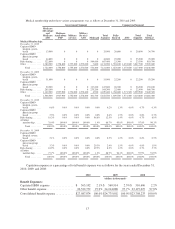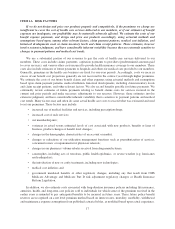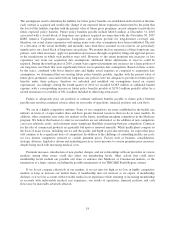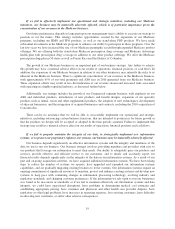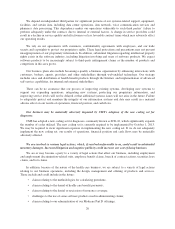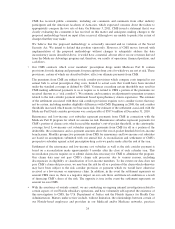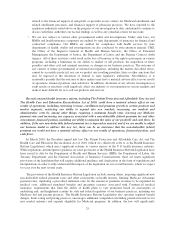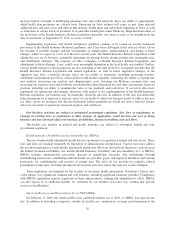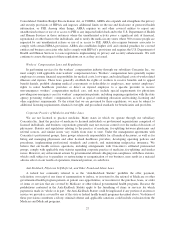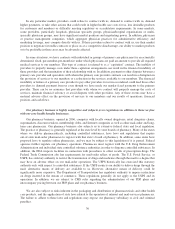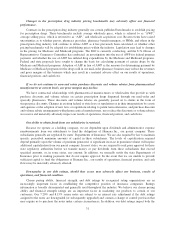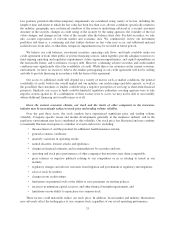Humana 2010 Annual Report Download - page 33
Download and view the complete annual report
Please find page 33 of the 2010 Humana annual report below. You can navigate through the pages in the report by either clicking on the pages listed below, or by using the keyword search tool below to find specific information within the annual report.Rico. These contracts accounted for approximately 2% of our total premiums and ASO fees for the
year ended December 31, 2010.
Effective October 1, 2010, the PRHIA awarded us three contracts for the East, Southeast, and
Southwest regions for a one year term with two options to extend the contracts for an additional term of
up to one year, exercisable at the sole discretion of the PRHIA. The loss of these contracts or
significant changes in the Puerto Rico Medicaid program as a result of legislative action, including
reductions in premium payments to us, or increases in member benefits without corresponding
increases in premium payments to us may have a material adverse effect on our results of operations,
financial position, and cash flows.
• There is a possibility of temporary or permanent suspension from participating in government health
care programs, including Medicare and Medicaid, if we are convicted of fraud or other criminal
conduct in the performance of a health care program or if there is an adverse decision against us under
the federal False Claims Act.
• CMS uses a risk-adjustment model which apportions premiums paid to Medicare Advantage plans
according to health severity. The risk-adjustment model pays more for enrollees with predictably
higher costs. Under this model, rates paid to Medicare Advantage plans are based on actuarially
determined bids, which include a process whereby our prospective payments are based on a
comparison of our beneficiaries’ risk scores, derived from medical diagnoses, to those enrolled in the
government’s original Medicare program. Under the risk-adjustment methodology, all Medicare
Advantage plans must collect and submit the necessary diagnosis code information from hospital
inpatient, hospital outpatient, and physician providers to CMS within prescribed deadlines. The CMS
risk-adjustment model uses this diagnosis data to calculate the risk adjusted premium payment to
Medicare Advantage plans. We generally rely on providers to code their claim submissions with
appropriate diagnoses, which we send to CMS as the basis for our payment received from CMS under
the actuarial risk-adjustment model. We also rely on providers to appropriately document all medical
data, including the diagnosis data submitted with claims.
CMS is continuing to perform audits of various companies’ selected Medicare Advantage contracts
related to this risk adjustment diagnosis data. These audits are referred to herein as Risk-Adjustment
Data Validation Audits, or RADV audits. RADV audits review medical record documentation in an
attempt to validate provider coding practices and the presence of risk adjustment conditions which
influence the calculation of premium payments to Medicare Advantage plans. To date, six Humana
contracts have been selected by CMS for RADV audits for the 2007 contract year, consisting of one
“pilot” audit and five “targeted” audits for Humana plans.
On December 21, 2010, CMS posted a description of the agency’s proposed RADV sampling and
payment adjustment calculation methodology to its website, and invited public comment, noting that
CMS may revise its sampling and payment error calculation methodology based upon the comments
received. We believe the audit and payment adjustment methodology proposed by CMS is
fundamentally flawed and actuarially unsound. In essence, in making the comparison referred to above,
CMS relies on two interdependent sets of data to set payment rates for Medicare Advantage (MA)
plans: (1) fee for service (FFS) data from the government’s original Medicare program; and (2) MA
data. The proposed methodology would review medical records for only one set of data (MA data),
while not performing the same exercise on the other set (FFS data). However, because these two sets of
data are inextricably linked, we believe CMS must audit and validate both of them before extrapolating
any potential RADV audit results, in order to ensure that any resulting payment adjustment is accurate.
We believe that the Social Security Act, under which the payment model was established, requires the
consistent use of these data sets in determining risk-adjusted payments to MA plans. Furthermore, our
payment received from CMS, as well as benefits offered and premiums charged to members, is based
on bids that did not, by CMS design, include any assumption of retroactive audit payment adjustments.
We believe that applying a retroactive audit adjustment after CMS acceptance of bids would
improperly alter this process of establishing member benefits and premiums.
23


